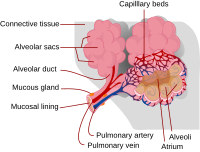
Photo from wikipedia
Non-invasive ventilation (NIV) given to the right patient, in the right setting, in the right way and at the right time improves outcomes. However, national audits reveal poor practice in… Click to show full abstract
Non-invasive ventilation (NIV) given to the right patient, in the right setting, in the right way and at the right time improves outcomes. However, national audits reveal poor practice in patient selection, clinical judgement, treatment initiation and availability of trained staff. NIV is indicated for persistent acute hypercapnic respiratory failure (AHRF) with acidosis after usual medical management in chronic obstructive pulmonary disease (COPD) exacerbation and even without acidosis in neuromuscular disorders or other restrictive conditions eg obesity hypoventilation or kyphoscoliosis. Having trained staff in a suitable environment with adequate equipment are keys to its success, along with close monitoring. A plan should be put in place at the time of initiating NIV about the ceiling of care, eg escalation to intubation or palliation, if the patient is not improving with NIV. Early NIV failure is most likely due to technical issues, such as inadequate pressures or mask leak, while late failure is usually the consequence of advanced disease. Any presentation with AHRF is a poor prognostic indicator and outpatient respiratory follow-up is indicated following discharge. For selected patients with COPD who remain hypercapnic 2 weeks after an exacerbation, domiciliary NIV can reduce admissions and improve survival. For patients with neuromuscular disorders or kyphoscoliosis a presentation with AHRF almost always indicates the need for domiciliary NIV.
Journal Title: Clinical medicine
Year Published: 2019
Link to full text (if available)
Share on Social Media: Sign Up to like & get
recommendations!